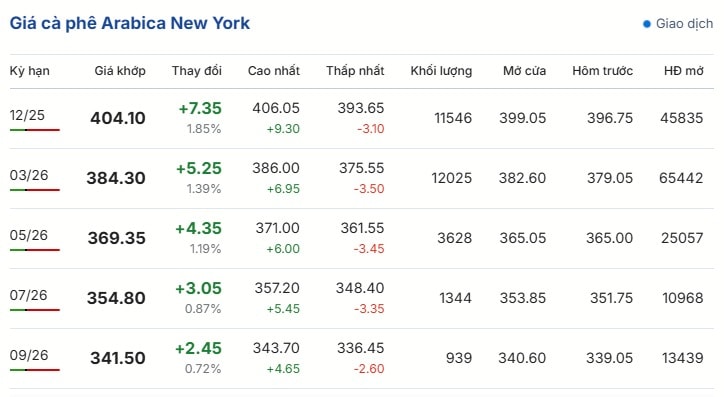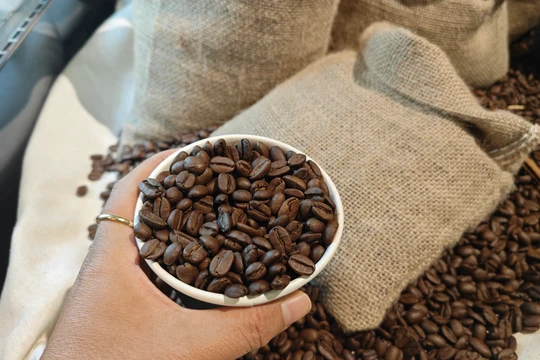Coffee price today November 8, 2025: Vietnamese coffee is thousands of times lower than foreign coffee
Coffee price today November 8, 2025: Central Highlands coffee price dropped sharply from 1700 to 2500 VND/kg. Vietnamese coffee is thousands of times cheaper than foreign Geisha coffee.
Update domestic coffee prices
Survey shows that coffee prices today in the Central Highlands region have dropped sharply from 1,700 to 2,500 VND/kg compared to yesterday, fluctuating between 115,700 - 117,000 VND/kg.
| Market | Medium | Change |
| Dak Lak | 116,800 | -2200 |
| Lam Dong | 115,700 | -2500 |
| Gia Lai | 116,500 | -1700 |
| Dak Nong | 117,000 | -2300 |
Specifically, in Lam Dong province, Di Linh, Bao Loc and Lam Ha areas decreased sharply by 2,500 VND compared to yesterday, trading at the same level of 115,700 VND/kg.
In Dak Lak province, Cu M'gar area is purchasing coffee at 116,800 VND/kg today, down 2,200 VND compared to yesterday. Meanwhile, Ea H'leo and Buon Ho areas are trading at 116,700 VND/kg.
In Dak Nong (Lam Dong province), traders in Gia Nghia and Dak R'lap decreased by 2,300 VND compared to yesterday, trading at 117,000 and 116,900 VND/kg, respectively.
In Gia Lai province, Chu Prong area is trading at 116,500 VND/kg, while Pleiku and La Grai are at 116,400 VND/kg, down 1,700 VND compared to yesterday.

Although Vietnamese coffee has set a record of 1.2 million VND/kg, it is still far from the 30,000 USD/kg price of foreign coffee. The difference lies in the plant variety, the altitude of the raw material area and the way the international market evaluates the value of coffee beans.
Last October, Julith in Dubai spent $600,000 to buy 20 kg of Nido 7 Geisha beans in Panama, equivalent to $30,000/kg. From this rare bean, they sold a cup of coffee for a record $980, nearly VND25.8 million, a figure that shows the "luxury" class of Geisha coffee.
Meanwhile, in Vietnam, the August 2024 auction recorded the highest price of 1.2 million VND/kg for the Arabica Huong Hoa (Quang Tri) lot, while Fine Robusta reached 720,000 VND/kg. This price is considered the peak in the country but is still thousands of times lower than that of Panama Geisha coffee.
Experts say the difference stems from rare flavors and market bias. Geisha coffee is grown at a special altitude, giving it a unique flavor, while Vietnamese coffee is still primarily seen as a mass-export product. However, Vietnamese specialty coffee is gradually asserting its position, promising to narrow the gap with the world.
Update world coffee prices
On the London Stock Exchange, the online price of Robusta coffee futures for January 2026 delivery closed on November 7 at $4,664 per ton, up 2.96% ($134 per ton) from yesterday. The March 2026 futures contract increased 2.2% ($98 per ton) to $4,556 per ton.

Similarly, the price of Arabica coffee for delivery in December 2025 on the New York Stock Exchange increased by 1.85% (7.35 US cents/pound) yesterday to 404.1 US cents/pound. The contract for delivery in March 2026 increased by 1.39% (5.25 US cents/pound) to 384.3 US cents/pound.

According to the General Statistics Office, Vietnam’s coffee exports in the first 10 months of 2025 reached 1.31 million tons, up 13.4% over the same period last year. This abundant supply puts the global robusta market under clear pressure.
The Vietnam Coffee and Cocoa Association (Vicofa) forecasts that coffee output in the 2025–2026 crop year could be 10% higher than the previous crop if the weather is favorable. However, heavy rains are slowing down the harvest in some areas of the Central Highlands, temporarily affecting export progress. Vietnam remains the world’s largest producer of robusta.
A report by Artis Trading and Coffee Trading Academy (CTA) forecasts that Vietnam’s coffee output in the 2025–2026 crop year will increase by 9.3% compared to the previous year, with robusta increasing by 8.8% and arabica by 19.5%, thanks to improved crop care techniques and increased productivity.
High coffee prices in recent times have encouraged farmers to invest more heavily in fertilizers and irrigation systems. Favorable weather conditions outside the crop season have also helped boost yields. According to the report, all surveyed coffee-growing provinces in the Central Highlands recorded better yields than the previous crop, strengthening Vietnam’s position as a coffee exporter.




.jpg)



